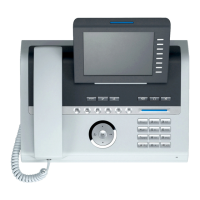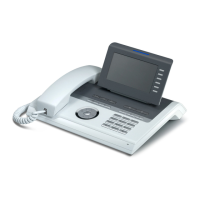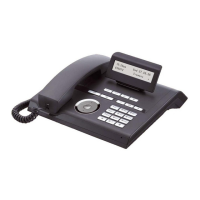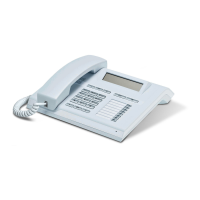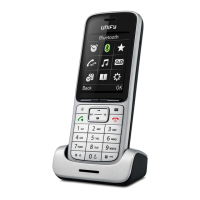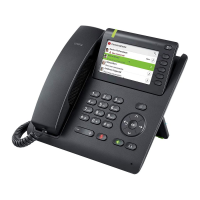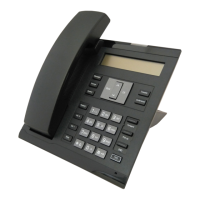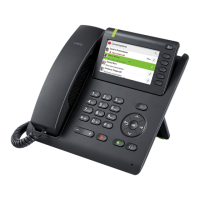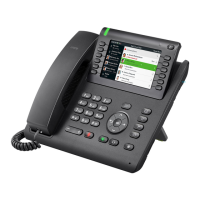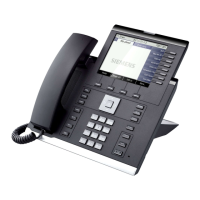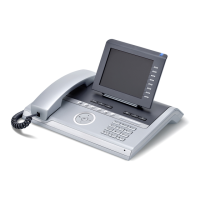
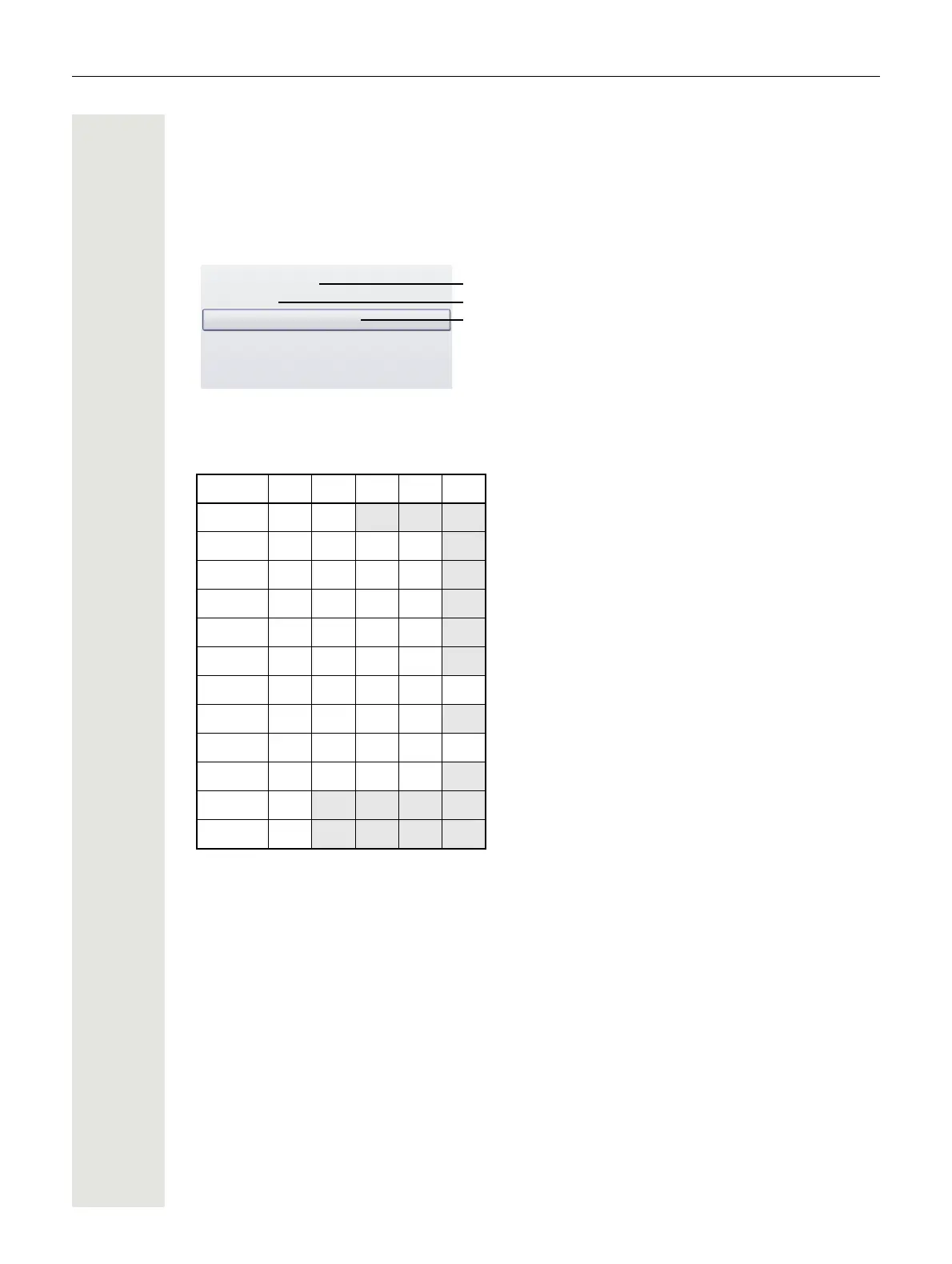 Loading...
Loading...
Do you have a question about the Unify OpenStage 60 T and is the answer not in the manual?
Safety warnings regarding power supply, opening the phone, and accessories.
Information about compliance with EU directives and product disposal guidelines.
Guidelines for optimal phone placement and environmental conditions.
Information and support resources available online.
Explains the purpose and scope of the user guide.
Information on obtaining technical support and contacting service personnel.
Specifies the authorized usage of the OpenStage phone.
Details on identifying the specific model and serial number of the phone.
Explains multi-line capabilities and team collaboration features.
Describes the phone's operating elements and displays with a diagram.
Diagram illustrating physical connection ports on the phone.
Compares features of OpenStage 80 T and 60 T models.
Information about the software for customizing phone settings and features.
Details about the accessory providing additional programmable keys.
Explanation of the purpose and operation of function keys.
Details on configuring audio settings and using the TouchSlider.
Explains how to use mode keys to switch between phone applications.
Guide on operating the phone's navigation control.
Instructions on navigating through call list and phonebook tabs.
Overview of programmable sensor keys and their functions.
Explains the status indications provided by LED lights on function keys.
Instructions on entering text, numbers, and characters using the keypad.
Explains the dual functions of specific keys like '*' and '#'.
How to customize the display's angle and design.
Explains the information displayed in the status bar and its icons.
Details on using the on-screen keyboard for text and character input.
Describes the phone's idle state and functions accessible from the idle menu.
Explains the prompts for data input and call state information on the display.
Defines the icons used to indicate message status and types.
How context menus appear and how to navigate them.
How to use pop-up menus for situation-dependent functions.
How to select content within applications using tabs and navigate.
Information displayed during calls, ringing, or dialing.
Defines icons representing different call statuses like active, held, or disconnected.
Explains icons and how to search contacts in the phonebook.
Details on using and managing the personal phonebook.
Information stored for each contact, including multiple numbers and data.
Accessing and using LDAP and system phonebooks.
How call and dialed numbers are logged and managed.
Specific details shown for call log entries, including time and date.
Sending/receiving text messages and accessing voicemail.
Accessing and using system and personal configuration menus.
Optimizing volume and ringtone settings for personal preference.
Settings for call forwarding, context menus, and password protection.
Accessing phone help and administration features.
Procedures for answering incoming calls via handset or speakerphone.
Using headsets and switching to speakerphone mode.
Monitoring calls and initiating calls via off-hook/on-hook dialing.
Making calls with headset, DDS keys, and ending calls.
How to decline an incoming call.
Muting microphone and initiating consultation calls.
Redirecting calls and requesting callbacks.
Managing saved callback requests.
Answering calls using a connected headset.
How to answer a call intended for a different phone.
Using speakerphone and controlling handsfree answerback.
Handling entrance phone calls and operating door openers.
Activating, deactivating, and using the door opener.
How to interact with calls from an answering machine.
Redialing from call lists and calling contacts from the phonebook.
Making group calls and using the system phonebook.
Searching LDAP and using system speed-dial numbers.
Programming speed-dial numbers to keys.
Making speaker calls and joining calls discreetly.
Automatic connections and reserving trunks for use.
Assigning station numbers and using dialing aids.
Managing incoming calls while on an active call.
Controlling call waiting signals and camp-on tones.
Placing calls on hold and picking them up later.
Putting external calls on hold and retrieving them.
Setting up, adding/removing parties, and ending conferences.
Exiting conferences and using DTMF signals.
Recording ongoing calls.
Transferring calls after group announcements and sending trunk signals.
Handling calls when destination is busy and joining ongoing calls.
Forwarding calls to a night station during off-hours.
How active call forwarding is shown on the display.
Lists different types of call forwarding available.
Modifying call forwarding settings.
Entering and copying destination numbers for call forwarding.
Storing frequently used forwarding destinations.
Quickly activating forwarding for all incoming calls.
Using the system menu to activate call forwarding.
Forwarding calls when there's no answer.
Removing or deactivating forwarding settings.
Forwarding calls via carrier network for multiple numbers.
Assigning functions to programmable sensor keys.
Lists functions for keys and explains LED indicators.
Status of application connections and functions without LED support.
Saving multi-step procedures to sensor keys.
Programming keys for redialing numbers.
Programming speed-dial numbers to keys.
Modifying the text displayed on sensor keys.
Removing programmed functions from sensor keys.
Adding contacts and defining default numbers.
Associating images with contact entries.
Editing existing contact information.
Customizing display format and deleting contacts.
Setting up and managing contact groups.
Removing contacts from groups and deleting entire groups.
Searching for contacts within the LDAP directory.
How search results are presented and handled.
Displaying details and removing entries from call lists.
Transferring call log entries to the personal phonebook.
Viewing call charges for the current or last call.
Viewing call charges for other phones.
Assigning external calls to projects using account codes.
Setting and managing the user password for menu access.
Activating/deactivating the ringer and silencing the ring tone.
Blocking calls and hiding caller ID for outgoing calls.
Silently monitoring ongoing calls.
Monitoring room audio and identifying anonymous callers.
Securing the phone against unauthorized access.
Locking other phones remotely.
Setting and managing the Personal Identification Number (PIN).
Setting timed reminders or appointments and managing them.
Handling timed reminders and composing text messages.
Displaying and deleting sent/received messages.
Leaving and removing messages for internal callers.
Viewing waiting calls and using other phones remotely.
Moving numbers and handling fax/answering machine signals.
Resetting phone services and controlling other phones.
Accessing system functions remotely via DISA.
Accessing ISDN functions using codes.
Interfacing with connected computers and systems.
Interacting with PC applications via CSTA.
Managing external relays and phone sensors.
Locating people using radio paging equipment.
Distinction between primary, secondary, private, shared, and direct call lines.
Automatic trunk assignment upon handset lift or trunk key press.
Using sensor keys as trunk keys for call management.
Explains LED indicators on trunk keys for line status.
Using trunk keys for calls, holding, and retrieving.
Switching between multiple lines for calls.
Function to allow team members to join conferences.
Using sensor keys for direct dialing to team members.
Explains LED indicators for Direct Station Selection keys.
Answering team calls and forwarding calls via trunks.
Turning off call forwarding for trunks.
Transferring calls directly to an executive's phone.
Enabling or disabling group call features.
Controlling audible tones for groups or trunks.
Answering calls for team members and managing ringing groups.
Managing UCD agent status at shift start/end and during the shift.
Managing UCD work time and night service.
Viewing the number of calls in the UCD queue.
Tilting the display and activating the screensaver.
Setting idle time for screensaver and adjusting image transition speed.
Customizing the appearance of the menu display.
Adjusting TouchSlider brightness and TouchGuide responsiveness.
Adjusting key label contrast for ambient lighting.
Setting volume levels for various audio signals and microphones.
Configuring acoustic settings for different room environments.
Configuring the phone for wired or cordless headsets.
Selecting ringtones and controlling the phone's ringer.
Adjusting volume during calls and using en-bloc dialing.
Selecting the preferred language for phone system functions.
Preparing the phone for Bluetooth connections and enabling the feature.
Setting phone visibility and assigning a Bluetooth name.
The process of establishing a secure Bluetooth connection.
Setting PIN and connecting/disconnecting Bluetooth devices.
Managing linked devices and blocked devices.
Scanning for available Bluetooth devices.
Accessing lists of paired or blocked devices.
Deleting all entries, renaming, or deleting specific devices from lists.
Configuring context menus to close automatically.
Defining how long context menus remain open.
Restoring phone settings to factory defaults.
Performing a device test to check phone functionality.
Explains Bluetooth basics like discoverability and linking.
Moving contacts between devices and importing vCard data.
Exporting contact data as vCards to linked or unconnected devices.
Connecting and using approved Bluetooth headsets and testing them.
Lists data types for backup and how to connect a USB stick.
Procedures for saving phone settings and data to a USB stick.
Choosing and restoring backups, including all user data.
Restoring specific types of data from a backup.
Verifying and removing stored backups on the USB stick.
Compares display differences between HiPath 3000 and 4000 systems.
Troubleshooting common error messages and their causes/reactions.
General troubleshooting tips for common phone issues.
Guidelines for cleaning and maintaining the telephone.
Icons used in application tabs for navigation.
Icons indicating phone status, messages, and call states.
Icons representing different phone number types in the phonebook.
